SQL coding can be a Wild West in multi-database environments.
Consider Ivana who has her hands full working in a tech startup. She’s the go-to person for all things database-related. Her company is using WordPress for their blog. So, MySQL will be the first thing in mind. Then, they acquired a SQL Server-based accounting package for their money-related stuff. Finally, they’re using a PostgreSQL-based CRM for their product sales.
Imagine coding from all these platforms for custom reporting, analysis, and more. You could see Ivana scratching her head during a stressful day. The chaos of the wrong syntax makes her pull her hair when the engine throws an error. How about using GETDATE() in PostgreSQL? And CREATE TEMPORARY TABLE in SQL Server? It never ends there.
She’s mixing stuff from different SQL flavors, and it’s making her crazy. Her integration job just can’t be easier.
So, she needs to be an expert “speaking” all these SQL languages to be productive.
Did you find yourself in the same boat?
You’re not alone. According to the State of the Database Landscape 2024 survey, a whopping 79% of organizations are now rocking two or more database platforms. That’s a big leap from 62% back in 2000!
So, it’s more crucial than ever to embrace multi-database environments. SQL coding is one part of it. And becoming efficient in coding is now a goal for database professionals to stay in the game.
But fear not. This post will give you what you need to up your game in SQL coding.
So, buckle up because we’re arming you with the features you need to be an SQL superhero once again.
Let’s begin.
SQL Coding Power Features for Efficient Coding and Higher Productivity
You still need to learn the nitty-gritty of each database platform. That’s a fact.
But it’s also a fact that your bosses won’t wait until you become an expert. You’re not alone in hearing them say: “We needed this feature yesterday!”. I used to hear that too.
So, you need to fast-track your studies by comparing what you already know from one database platform to the next. If you’re already an expert in one, that’s great. The best practices in one should have an equivalent in another. And to help you apply your newfound knowledge in your next platform, you need a tool. A GUI tool.
But the question is: What sort of GUI features do you need?
The following sections will reveal the smart features to supercharge your coding powers. And eventually, to skyrocket your productivity.
Ready? Let’s dive in!
SQL Code Completion: A Trusty Assistant That Helps Finish the Correct SQL Statement
Do you have a friend who can finish the sentence you’re saying? He knows you a lot that it’s like he can read your mind.
SQL code completion is like that. Or, at least, it’s the next best thing. It’s like having a trusty sidekick who finishes your SQL statements for you.
The moment you type INSERT, it knows you’re going to type INTO. So, it suggests it to you. Even more after that, it can suggest the tables you may need. And if you type the first few letters, the list of tables is narrowed down for you. All you have to do is pick the one you need.
And in a multi-database environment, it knows when to use NVL, ISNULL, or COALESCE. It won’t ask you for the ENGINE when you’re creating a table in SQL Server. Because that’s a MySQL thing. It’s like a friend who is fluent in several languages.
Going back to Ivana, an amazing IDE will help her save her sanity in SQL coding. It could be a feature she’s been looking for.
But that’s not all. She can become a productivity warrior by reducing errors and saving time. No more second-guessing and less hunting through documentation.
Take a look at some examples below.
The SQL code completion feature should know your database, so that it can suggest joins for you. Like the following SQL code in Oracle:
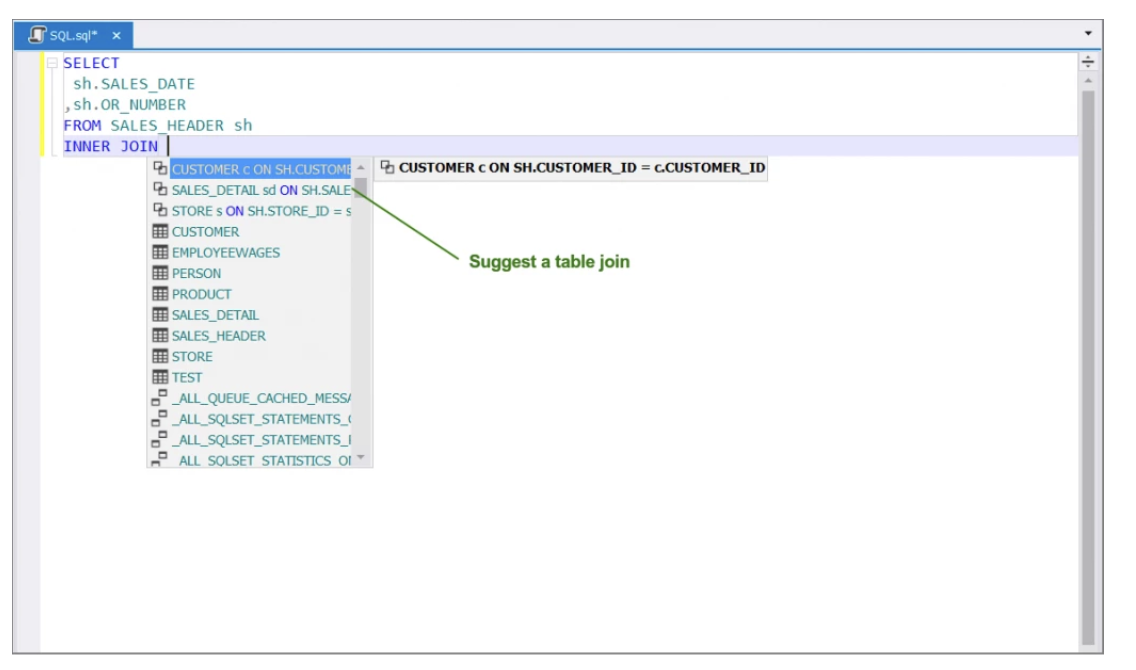
It should also know the underlying platform, so, the SQL dialect suggested should match. Like this one for MySQL:
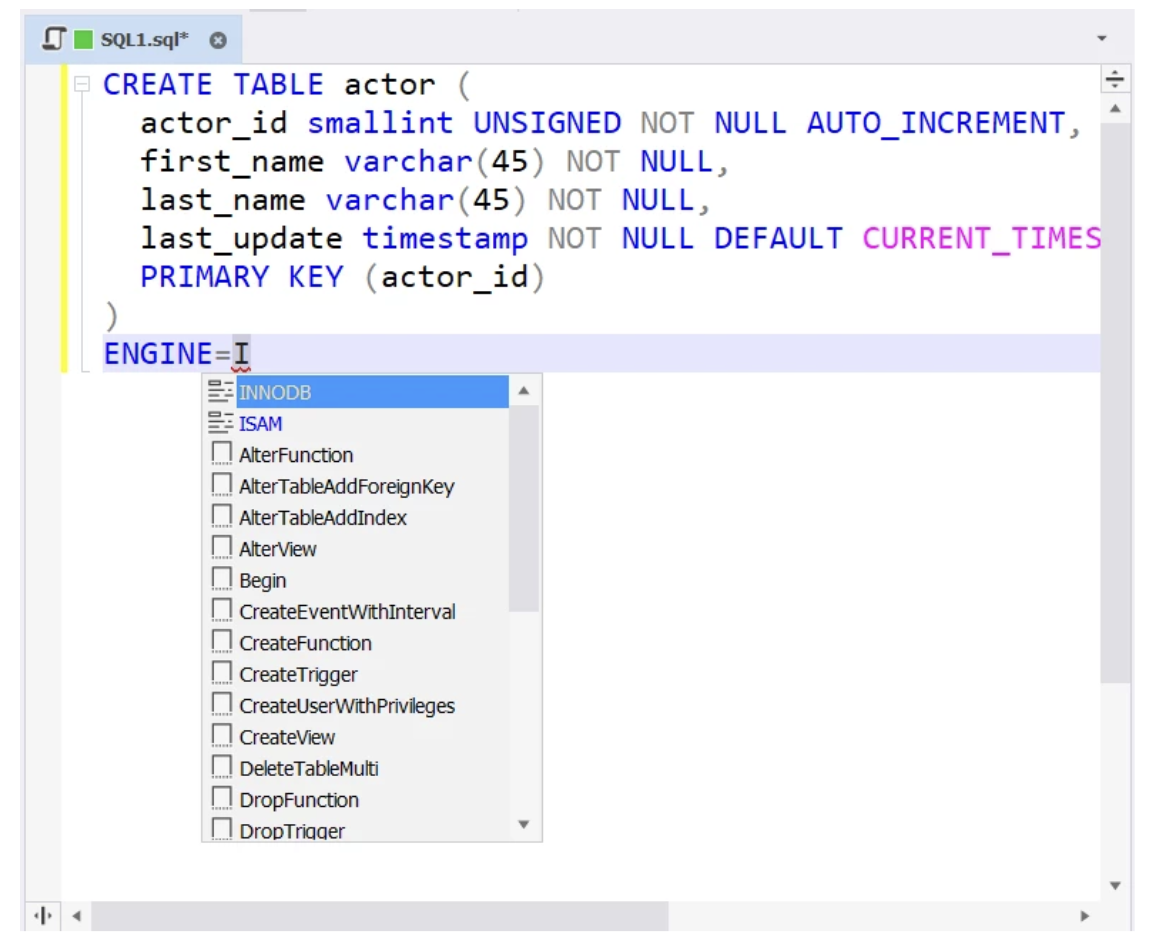
And this one for PostgreSQL:
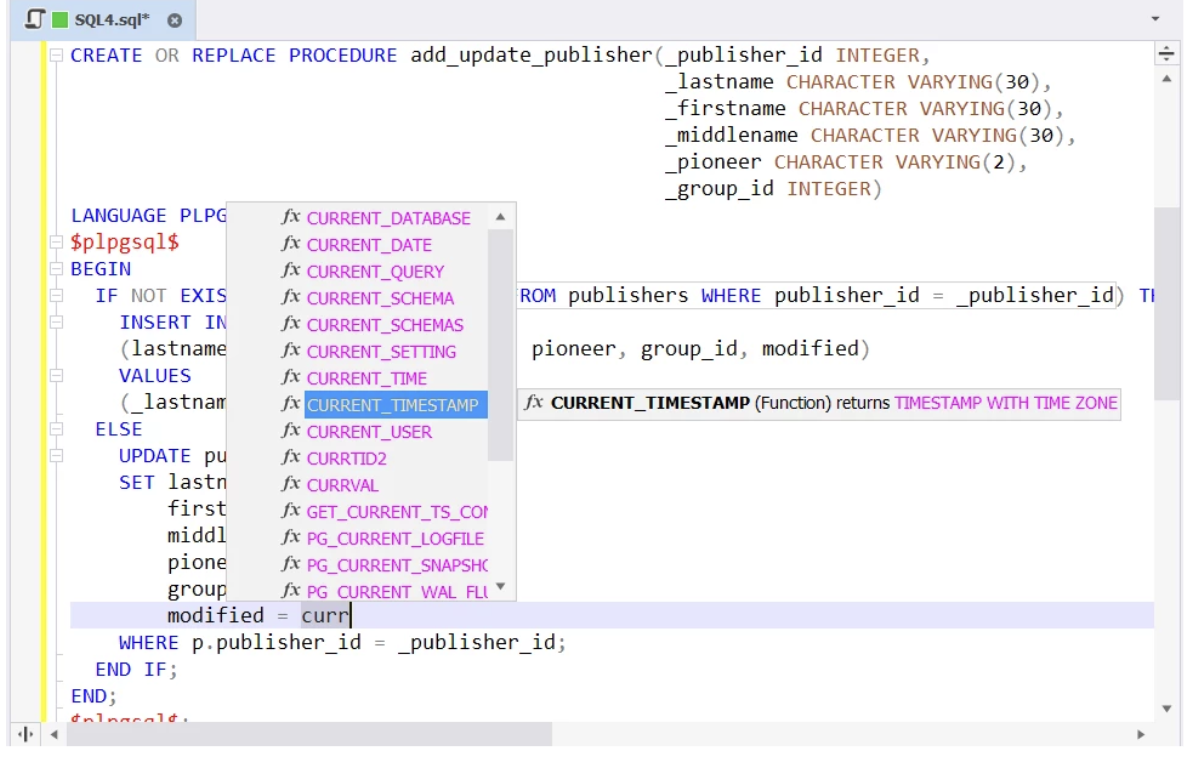
Of course, it should know all of the Big 4 databases. So, you can also trust SQL coding assistance for SQL Server:
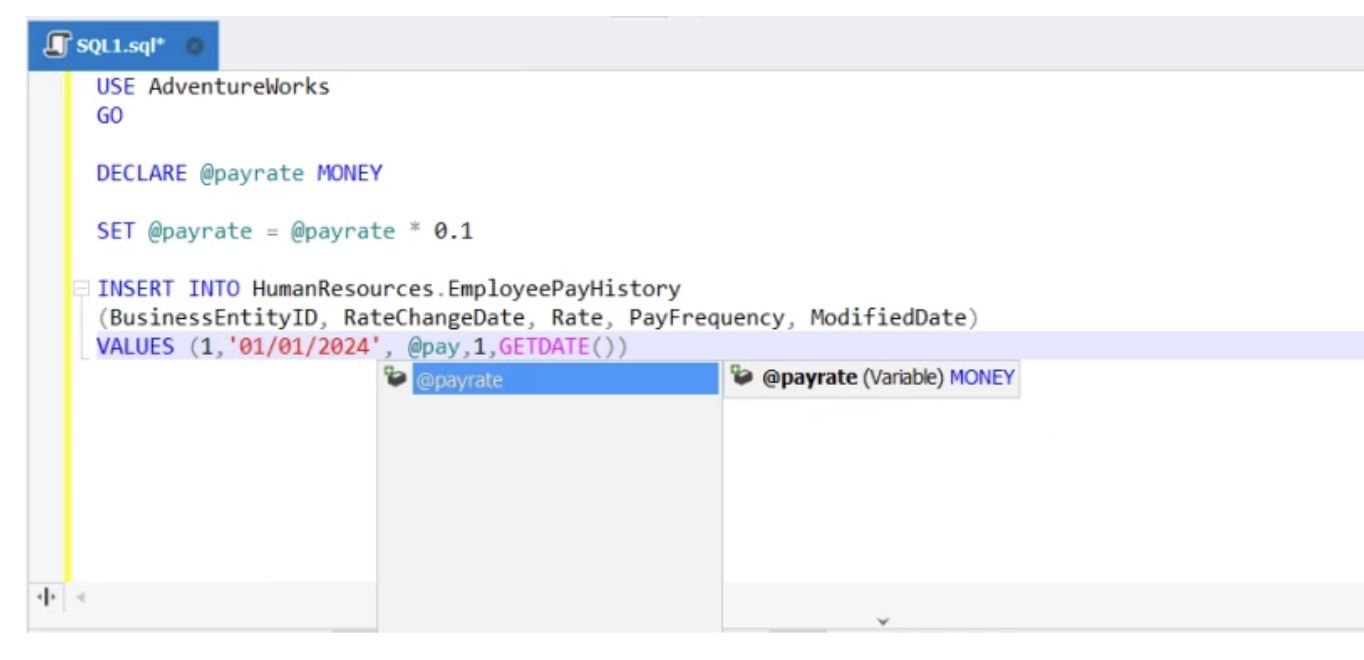
So, if you’re ready to level up your SQL coding game, SQL code completion is just around in a good IDE.
SQL Code Formatting: Keeping Your Code Neat and Tidy
Ivana’s time-pressured script writing finishes on time. She had to write off that task for good. The next day, she glanced at her code.
To her surprise, she had to re-read them again to understand what a line of code means. It’s a mess. One line of a SELECT statement follows a series of columns. Then, another has each column in another line. Then, a subquery is added to the mix. The spacing, line breaks, and indents are all over the place. It’s confusing!
She could have an Oh-so-readable code. It’s something organized, consistent, and clean. A glance at her code will trigger her brain tissues to process it quickly. Her brain’s hippocampus thanks her and makes her recall what a line of code means.
That’s where SQL code formatting comes into play.
The code aesthetics will make you smile. It’s good for your brain’s limbic cortex (it affects your mood).
But it doesn’t end there.
Well-formatted code is easier to debug, troubleshoot, and collaborate on. Say goodbye to code chaos and headaches. And say hello to beautiful, maintainable code. Whether it’s a complex join or a nested subquery, it’s clear as a good sunny day.
Let’s take the following example using MySQL:
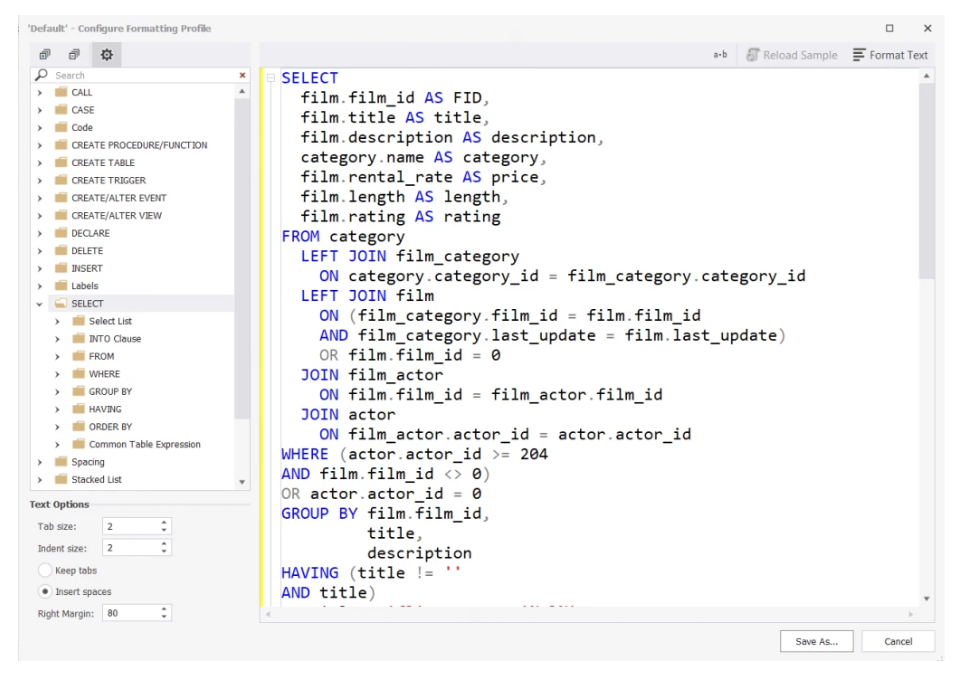
Then, again, it won’t be a problem with a different SQL flavor. Using PostgreSQL formatter this time:
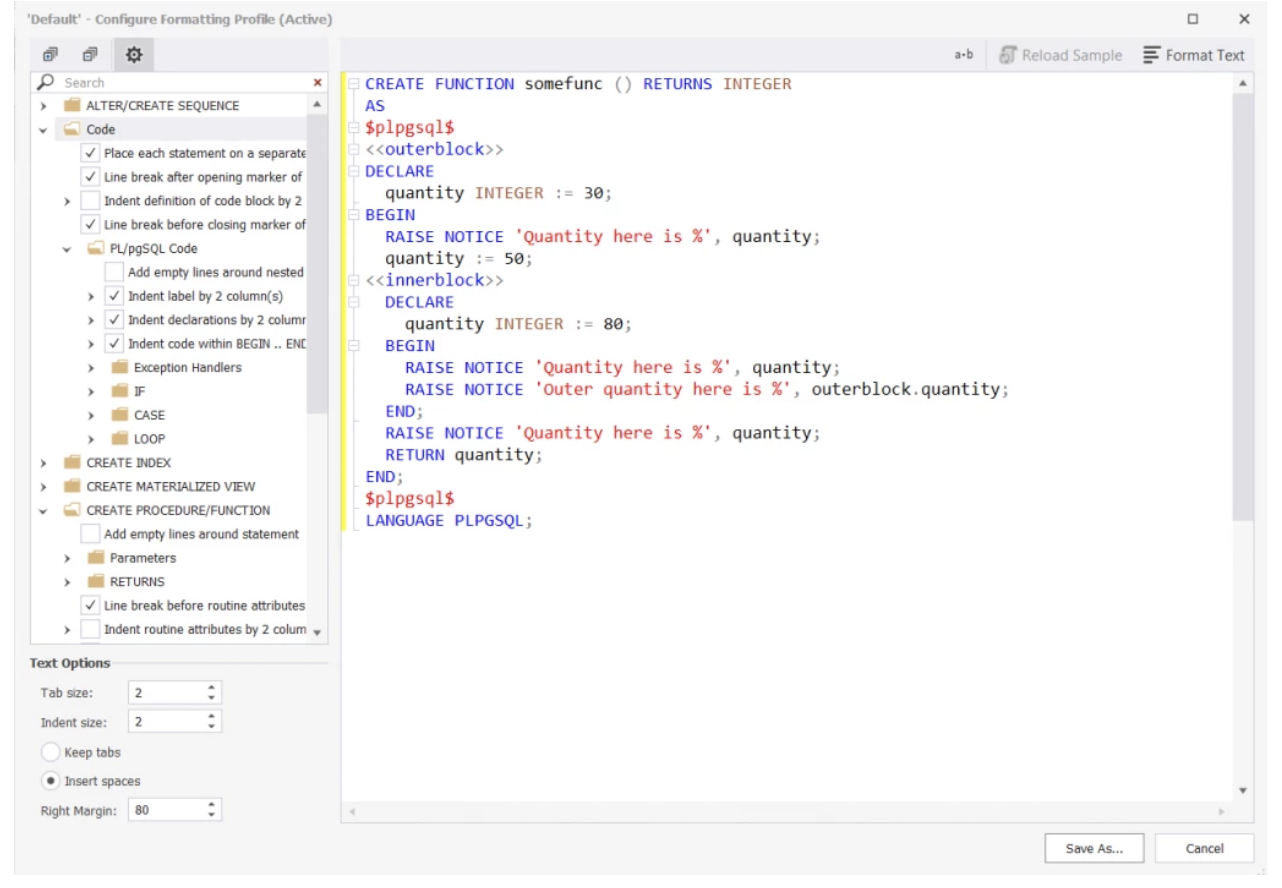
So, are you tired of staring at messy code and longing for a cleaner, more organized approach? Then, SQL code formatting is the friend you never had before.
SQL Code Refactoring: No More Hit and Miss with Dependencies
How hard can renaming database objects be? If you don’t have an IDE that can manage dependencies, it’s a hit-and-miss every time. Well, with SQL refactoring, never miss a dependency when renaming columns, variables, and more!
It could have been better for Ivana if she had an IDE that could handle this. In her script, she found out that some variables could have been named better. So, she needs to rename them. Without a good IDE that can handle refactoring, she could miss something. And her script will throw an error.
In your case, it might not be a variable but a table column. Handling ALL the dependencies is a tall order depending on the number of objects in the database. But a sleek IDE can handle it.
Here’s a sample of Oracle code refactoring to rename ADDRESS to HOME_ADDRESS.
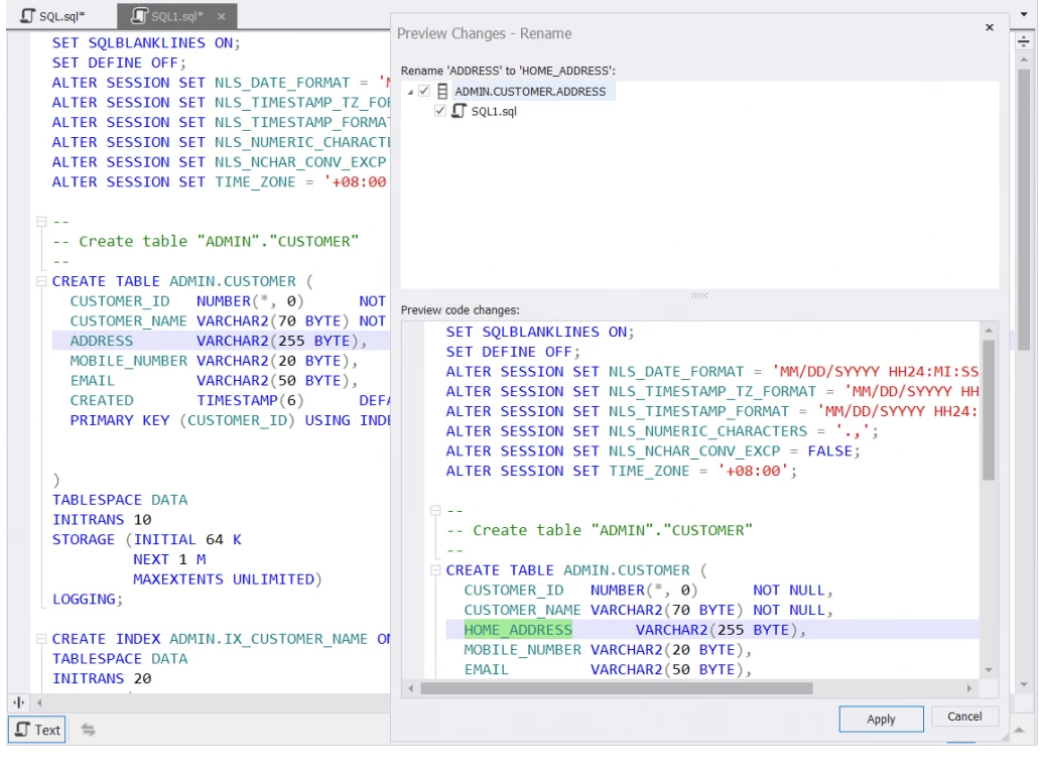
And here’s another for MySQL:
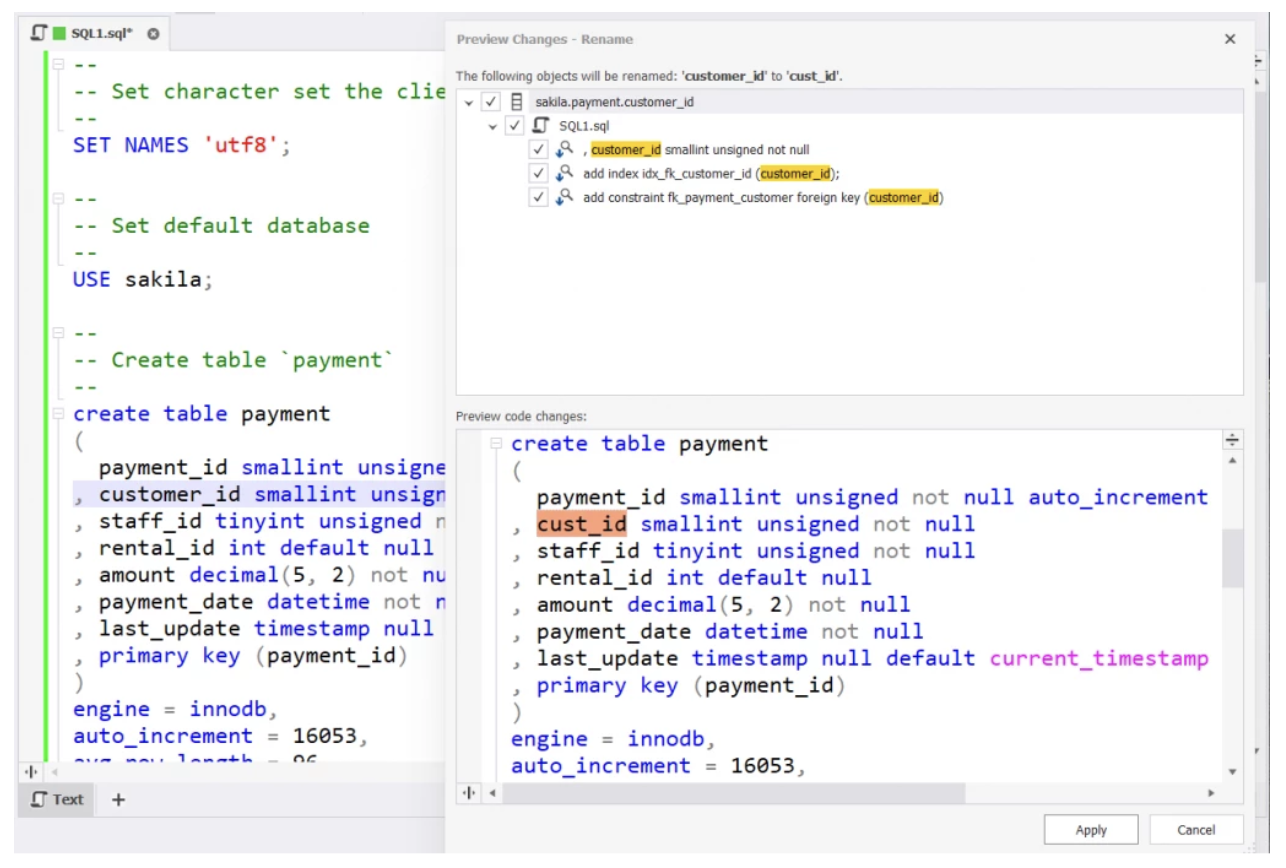
So, if you’re sick of errors by handling all the dependencies yourself, it’s time to say hello to SQL refactoring. It could be a lifesaver later.
SQL Code Debugging: Unraveling Mysteries and Squashing Bugs
Dealing with syntax errors is one thing. But dealing with logic errors is another.
Have you ever experienced running a stored procedure without runtime errors, but the result is a train wreck? That’s logic error. And that’s something that calls for a debugger.
Back in the day, you could print variable values, display query results, isolate a portion of code, and many more. All these are to get to the bottom of the problem in your SQL code. But the days are gone when IDEs have a built-in SQL code debugger.
You can trace SQL code line by line as you do in C# with Visual Studio. You can also add breakpoints and watches. Then, inspect variable values.
With all these, you can get to the bottom of the problem faster. And you can focus more on fixing it.
Sounds good?
Ivana says yes. Because she had inconsistent totals from 2 reports with the same table sources.
As an example of debugging, check out the MySQL debugging below with tracing and breakpoint.
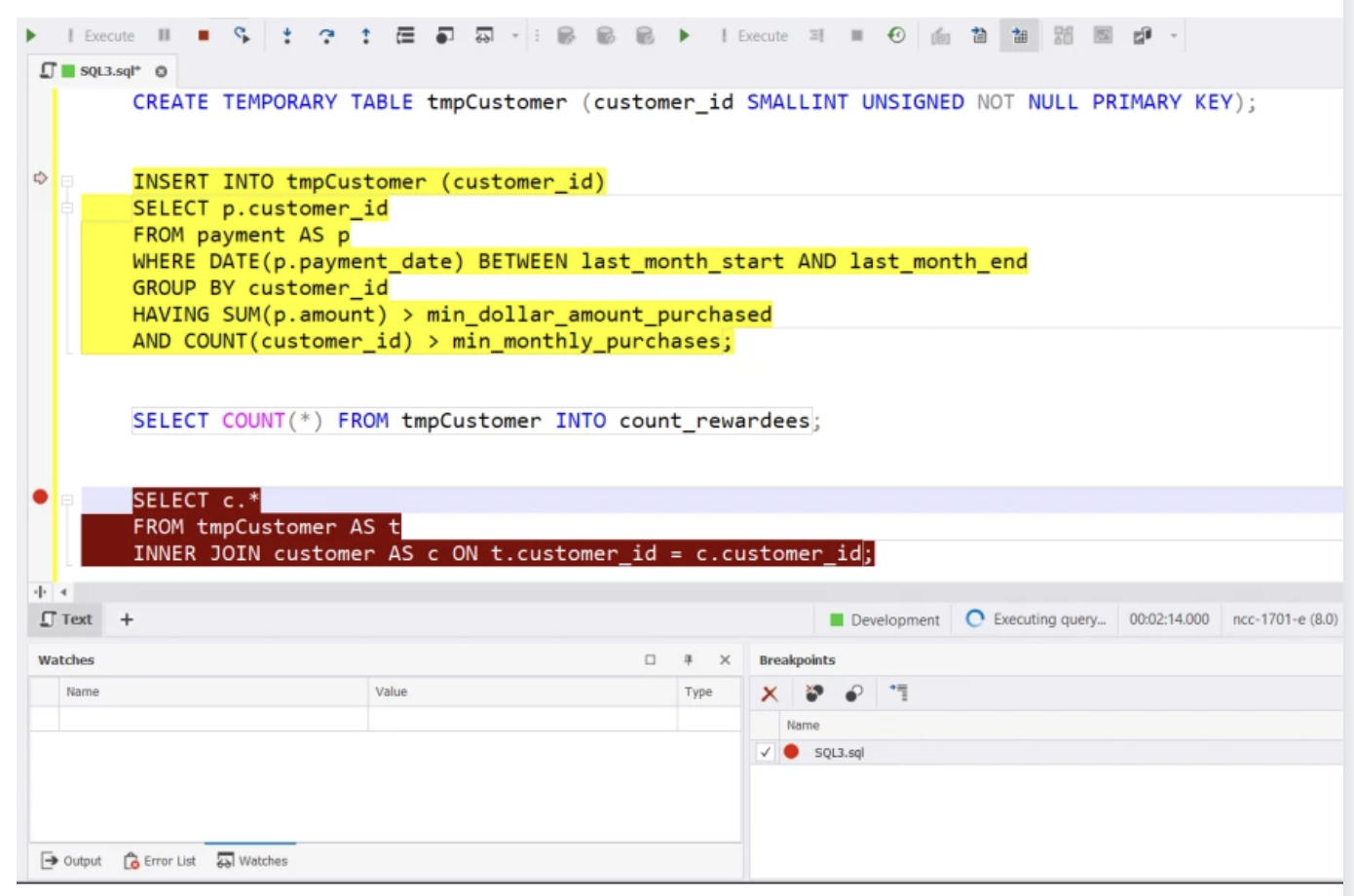
So, are you tired of banging your head against the wall trying to decipher a logic or runtime error? Then, SQL code debugging is like a detective that can solve the crime of SQL errors. With it, you can squash bugs like never before.
Other Features That Keep Productivity Up
Do you want more power-ups in the game of SQL coding?
Of course, you do.
So, here are some more features that will transform your SQL code from meh to amazing.
SQL Code in Color with Syntax Highlighting
First up, you need to color your SQL code pad.
But what’s the big deal?
Have you used Notepad or a similar text editor where the colors are black and white? When errors occur, what happens? It’s still black and white, right?
But will it be nice to add a red squiggly line where the error occurred in your code? Of course, because you can spot the errors quickly.
But there’s more.
How about making the code easier to read by using a different color for keywords, literals, variables, and more? Much better, isn’t it?
Have you seen the samples above? Keywords, literals, and more have different colors to distinguish one from the other. The difference is like night and day between black and white and a touch of some colors. You won’t be watching TV like it’s the 50s today. In a similar sense, you’ll be better off to color code your SQL code.
SQL Code Snippets and Code Generators
Next, we have code snippets or templates and code generators. With just a few keystrokes, you can access pre-built templates for common SQL commands. It’s a time-saver when writing repetitive code. Or right-click a table and generate an INSERT, UPDATE, or DELETE statement. Whether you’re crafting a SELECT statement or creating a new table, code snippets and generators are your friends. Below is a sample for the INSERT statement:
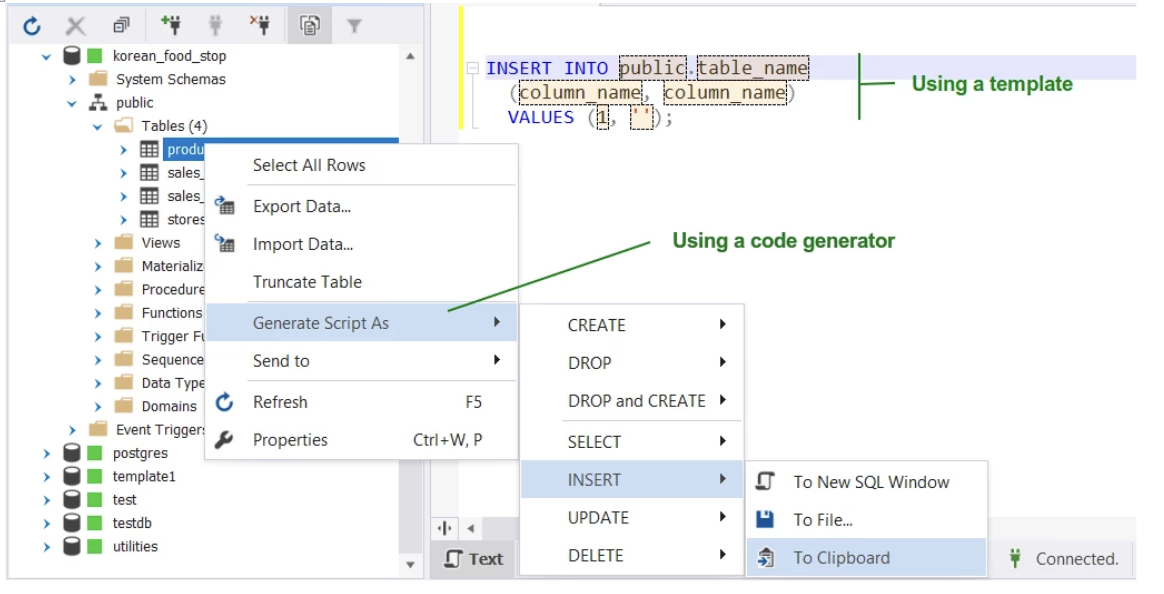
With the template activated, just fill in the boxes for the correct object names. And if it’s running in tandem with code completion, you have a lazy man’s way to finish the INSERT statement.
The code generator, on the other hand, has a different game. All objects are filled in for you. Just type in the VALUES for the INSERT statement. Cool!
Quick Object Information with Tooltips
Then, there are tooltips. These handy little pop-ups provide information about variables, columns, and more. It promotes consistency in handling data types and sizes. With tooltips, you can quickly check the data type of a column or variable without referring back to the schema definition.
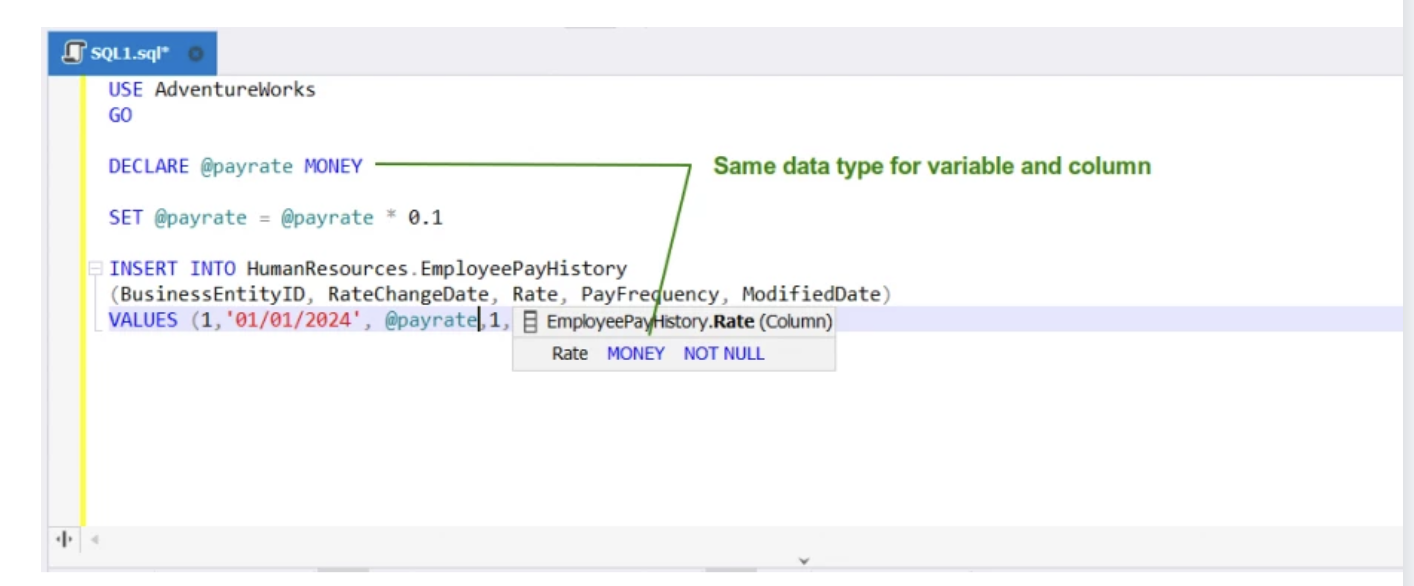
Data Generator
And let’s not forget about data generation. SQL code is nothing without data. Every SQL professional needs data to test for correctness and performance. And a good data generation tool is worth its weight in gold.
With data generation, you can create realistic test data with just a few clicks. It saves you time and helps you test your code before deployment.
Look at the sample below. It can generate realistic customer names, home addresses, and more.
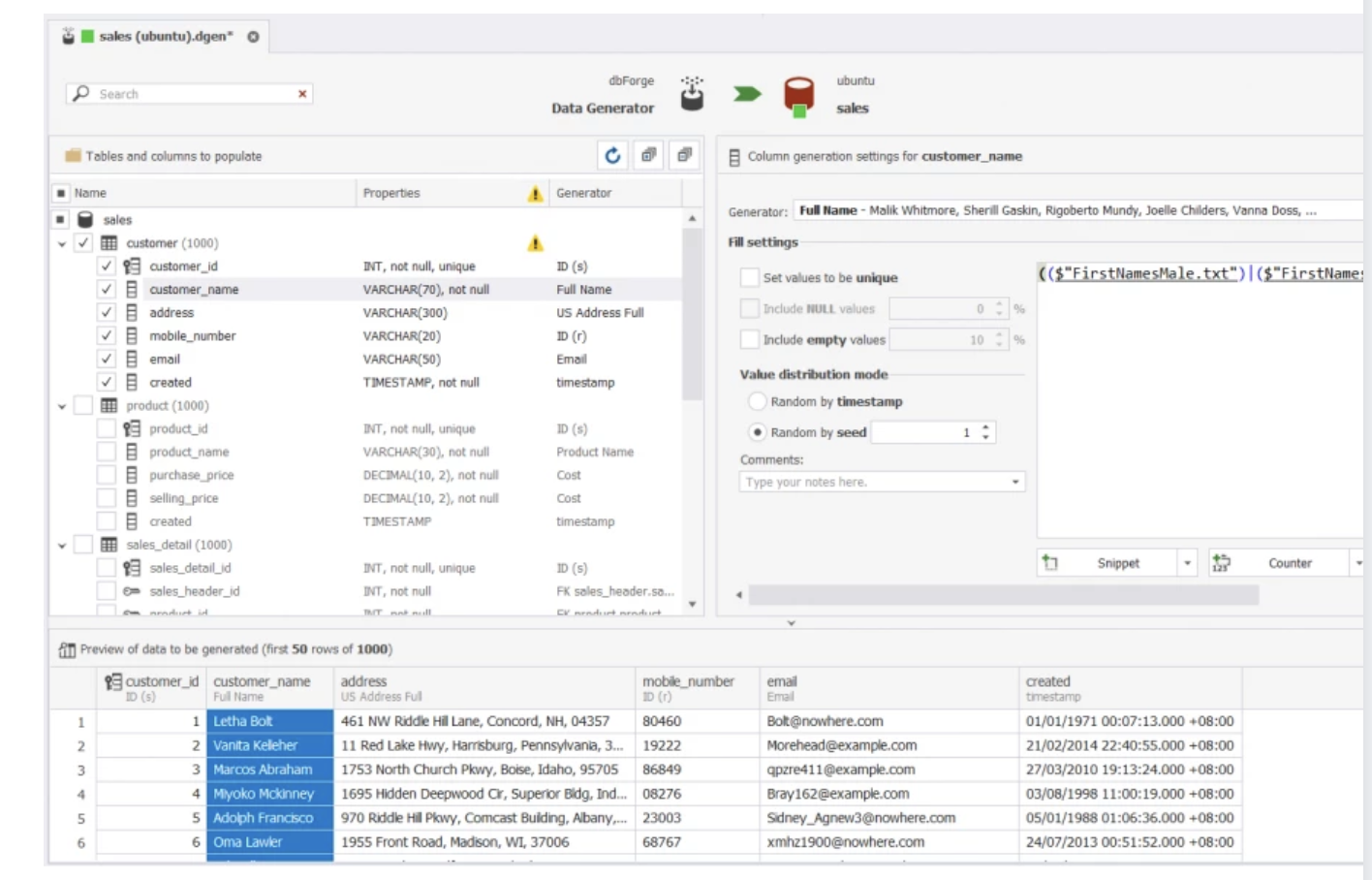
A good data generator can also make data that won’t trigger errors because of foreign keys.
Could be a dream come true. No more using aaaa, bbbb, testname, 1111, and the like for your test data. And how about disabling foreign keys to add lots of data at once? It’s a thing of the past.
Pinpoint Performance Issues with Query Profiling
Last but not least, we have query profiling. This powerful feature allows you to pinpoint performance issues in your SQL statements. You can also compare different performance profiles as your code changes. With query profiling, you can fine-tune your code for optimal performance. Then, ensure your applications run smoothly in production.
Check out the visual EXPLAIN for PostgreSQL below:
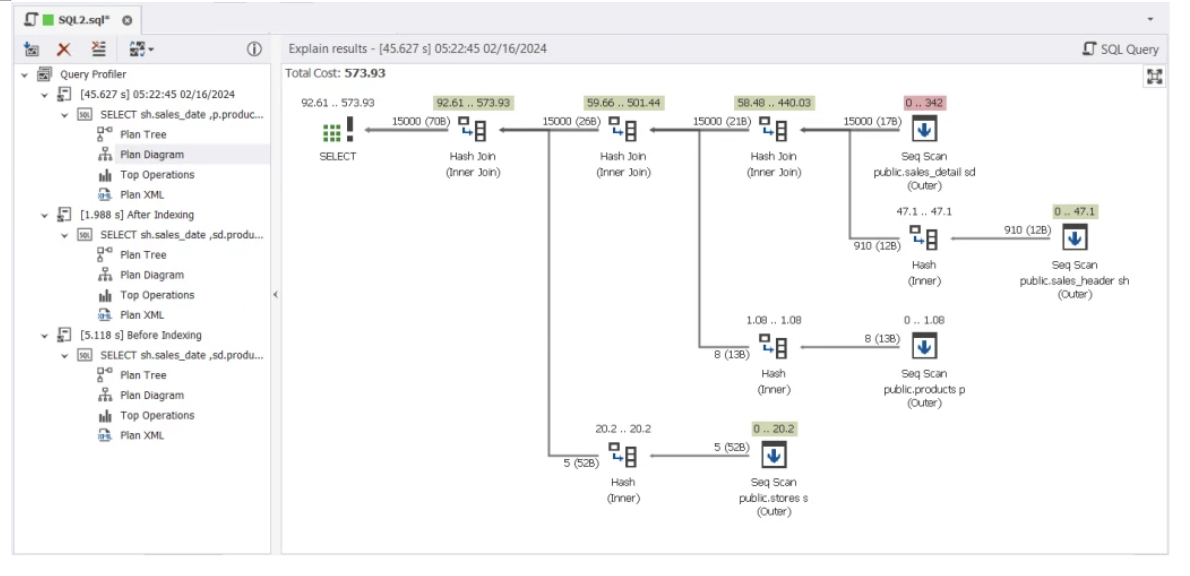
These are all the bells and whistles of a good SQL IDE. But is there a tool that has all these features?
dbForge Edge: The Mighty IDE for SQL Server, MySQL, MariaDB, Oracle, and PostgreSQL Coding and More
Meet dbForge Edge
This is your go-to companion for all things multi-database. It covers the Big 4: PostgreSQL, MySQL, SQL Server, and Oracle. But add MariaDB to the mix. This is good whether your database lives on-premises or in the cloud.
But just like me who codes SQL every day, I need something “fluent” in all the mentioned SQL linguae. That’s dbForge Edge. The environment uses the same UI elements and workflow. So, switching between different SQL flavors is not like going to a place you’ve never been before. You know the feeling.
It addresses every aspect of SQL coding already discussed. So, it’s a sure boost in SQL code efficiency.
But there’s more.
You can change the IDE to your liking with IDE themes. Not a fan of the light theme and favor the dark one? You can have it. If you don’t like the blue color for SQL keywords, you can change it. Even the fonts can be changed.
You even have database diagramming, reporting, data pivoting, security management, and more.
So, you can be a developer, designer, administrator, and analyst. You can shift SQL hats if you want to with the same versatile tools.
With dbForge Edge, you can start your goal of becoming an SQL master now.
The Grand Finale: A Tale of SQL Coding Triumph
Coding in multi-database environments poses a mountain of challenges. But facing it head-on is the way to go. It’s becoming the norm these days.
In that case, companies like Ivana’s want to adjust quickly. So, acquiring a GUI tool like dbForge Edge will help them get there and become triumphant in their quest for SQL coding efficiency. With it, they have smart code completion, formatting, and refactoring. Troubleshooting becomes a breeze with a nifty debugger. All in the name of productivity and efficiency.
Ivana’s tale has shifted from misery to bliss when she started using dbForge Edge. Coding becomes fun. No more messy code to maintain. And the bugs? They’re now easier to squash. dbForge Edge is now her trustworthy friend.


 27.1K
27.1K
 9.92%
9.92%
 22
22


 < 5K
< 5K
 17.89%
17.89%
 4
4


 15.6K
15.6K
 66.97%
66.97%
 4
4


 874.9K
874.9K
 22.98%
22.98%
 12
12


 1.4M
1.4M
 16.95%
16.95%
 5
5


 5.5K
5.5K
 62.75%
62.75%
 7
7


 < 5K
< 5K
 14
14


 < 5K
< 5K
 31.34%
31.34%
 4
4


 11.1K
11.1K
 38.23%
38.23%
 2
2


 61K
61K
 31%
31%
 3
3


 247.3K
247.3K
 26.72%
26.72%
 5
5


 14.5K
14.5K
 62.5%
62.5%
 2
2


















































